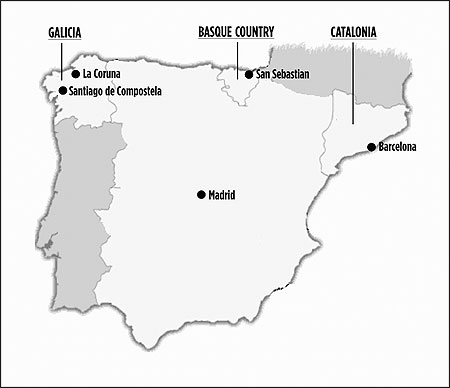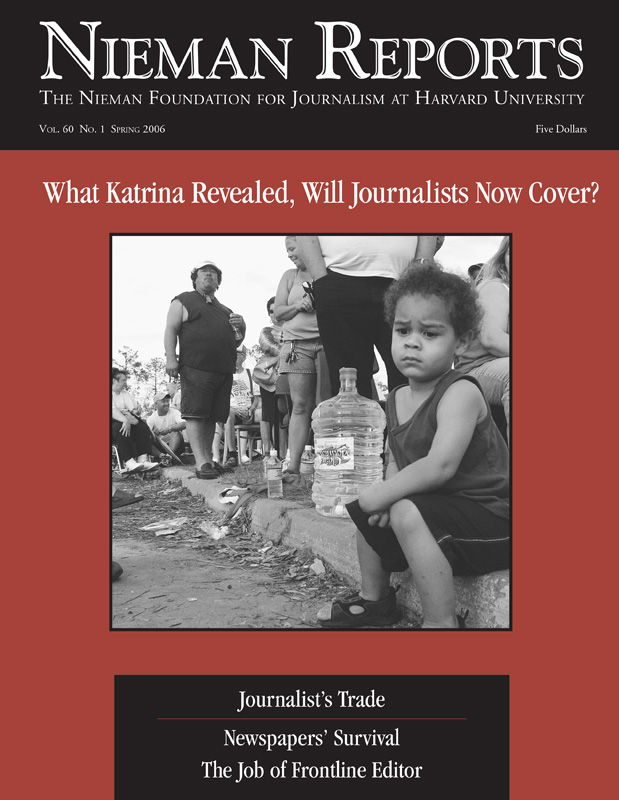Mention bilingual journalism, and Miami or the Tex-Mex border towns come to mind. But journalism’s definitive “bilingual belt” is an ocean away in northern Spain, where a ribbon of regional languages has made the area a hotbed for linguistic risk-taking.
Spanish may be the country’s official language, but troll the tapas bars and eavesdrop on conversations going on in the regions of Catalonia, Galicia and the Basque country, and other languages will be heard. Once smothered by former dictator Francisco Franco, the regional languages — Catalan, Galician and Basque — have undergone a rebirth since his death in 1975, claiming greater prominence in schools and society and becoming symbols of the regions’ desires for greater autonomy. That nascent nationalism, combined with new translation technologies, has ushered in the beginnings of a bilingual era in the Spanish newspaper industry.
Or so it seems. Doing dual-language journalism in Spain has never been easier, cheaper or more culturally appropriate — so why does this approach appear to be failing? How is it that Galicia Hoxe, the only all-Galician newspaper in a region of three million Galician speakers, barely musters 4,000 in daily sales? Why, in highly nationalistic Catalonia, has the Catalan-only and publicly financed Avui faltered against the likes of all-Spanish giant La Vanguardia? Why are these larger papers reluctant to adopt more bilingualism?
Those questions are confounding editors and industry experts, and they provide a peek into the bilingual journalism dichotomy unfolding there. Spain is a case study and a cautionary tale — a lesson in bilingual innovation but also a warning that such efforts, however well-intentioned, don’t always translate into readership gains. For editors in bilingual regions such as Southern California or Texas, the message might be this: Even as technology and cultural forces pave the way for language-mixing journalism, it might be that readers don’t really want their news delivered in this way.

Graphic by Seth Lewis.
The Spanish Models
Bilingual journalism in Spain is marked by its politics and peculiarity.
The politics are hard to ignore, in part because so much of Spanish news focuses on political posturing and carries a partisan undertone and because the country’s minority languages have become synonymous with regional separatist movements. By encouraging, if not enforcing, conformity to the local tongue in everything from street signage to restaurant menus, local governments — particularly those in Catalonia and the Basque country — have turned language into a political tool that emboldens but also isolates their regions.
For some newspapers, this dynamic has made the minority languages hot to the touch, almost radioactive, casting their coverage in a nationalistic glow and alienating more than a few readers who prefer their news straight, undiluted — and, yes, in Spanish.
As for peculiarity, consider the bilingual potpourri that nationalism has spawned:
- At El Periódico de Catalunya, the second-largest newspaper in Barcelona, a team of editor-linguists can, with a few mouse clicks, translate a completed Spanish page into Catalan in minutes. Add a bit of proofreading and presto! A 96-page edition has been duplicated in just a few hours.
- Across town, in the offices of Metro Catalunya, the staff is constantly mixing the languages, with newsroom discussions in Catalan, some phone interviews in Spanish, then writing in both. The result is a popular free daily with a front page that’s part-Catalan, part-Spanish.
- Meanwhile, in Santiago de Compostela, a destination for Catholic pilgrims near the Atlantic coast, Galicia Hoxe churns out 48-page daily editions of Galician news, written in Galician and with a bold Galician spin. In the same newsroom, a different staff is producing different news for the stuffier all-Spanish parent paper, El Correo Gallego.
- Just up the road in La Coruna, the region’s leading newspaper, La Voz de Galicia, mixes the languages on its culture pages and, in its metro section, occasionally runs a Galician quote smack in the middle of a Spanish story.
Confused yet? Spain is turning out a head-spinning array of bilingual offerings, most of which fall under three categories:
- Production bilingualism: The news is produced by one staff and then disseminated in two languages, usually with the help of computer software that nearly seamlessly translates one Romance language to another. Barcelona’s El Periódico de Catalunya epitomizes this approach. It publishes identical editions in Spanish and Catalan, with the latter making up more than 40 percent of its press run. “We are a bilingual society,” said Joan Busquet, the paper’s languages director. “We said to ourselves, ‘If someone can buy bread in Spanish or Catalan, why can’t they read a newspaper in either language?'”
- Content bilingualism: In this, the most common form of bilingual journalism in Spain, the newspaper produces a single edition in Spanish, but with a sprinkling of the local language. Take the case of Gara, which mixes Spanish and Basque as it signals the rebirth of a newspaper once shut down by the Spanish government because of its ties to the Basque terrorist group ETA. Like other bilingual papers, Gara takes an activist approach to pushing the minority language: “Sometimes we’ll publish in Spanish to reach more people, or we’ll publish in Basque to uphold our obligation to support Basque,” Gara editor Josu Juaristi said. Meanwhile, among the less politically motivated, Metro Catalunya, 20 Minutos, and Qué!, three free dailies with a growing share of the commuter market in Barcelona, often present locally produced stories in Catalan right alongside Spanish copy from their Madrid bureaus and wire services.
- Tailored bilingualism: Other papers try targeted editions — perhaps a four-page weekly section — as a nod to its minority language. At the other extreme is bilingualism with an attitude. Galicia Hoxe, unlike its all-Spanish parent, El Correo Gallego, unabashedly presents the news through a Galician lens — rewriting wire copy and giving language and culture concerns top billing in coverage. “If we see a report that the youth in Vigo are speaking less Galician, for us that’s a front-page story,” Hoxe deputy editor Xavier Cae said. “For El Correo Gallego, it will be a little note inside.”
What Goes Bilingual?
Such linguistic mixing and matching adds a new layer to editorial decision-making: In what language should a story appear? Most newspapers practicing content bilingualism have a similar standard: The more local an item, the more reason it should appear in the local language. For papers in Galicia, where the once-rural tongue of Galician today has become the language of the elite, that means high-brow sections such as arts and culture appear in Galician.
At La Voz de Galicia, most local stories appear in Spanish, but if a reporter goes to an accident scene, for example, and a witness responds to questions in Galician, the paper will run the quote in Galician — inside an otherwise Spanish story. “The reader understands perfectly, and it’s more realistic,” executive editor Bieito Rubido said.
At Metro Catalunya, where the Barcelona-produced content usually appears in Catalan, language choice is a fluid, day-to-day process. “The reporter will say, ‘Do you want this in Spanish or Catalan?'” Editor Xavier Gual said. “And then we’ll decide based on what else we have that day. We want to provide a good mix of the two.” In seeking an 80-20 Spanish-Catalan ratio, Gual tries to help the many Latin American immigrants assimilate to Catalonia by giving them just a taste of Catalan. “We don’t want to make it hard for the reader,” he said.
And therein lies the rub: Do readers really want this kind of journalism?
Recent evidence is not encouraging. In Galicia, the all-Spanish El Correo Gallego outsells its all-Galician sister by 10-to-one — and good luck trying to find folks reading Galicia Hoxe over chocolate con churros in local cafés. In Catalonia, a region of nearly seven million Catalan speakers, the Catalan-only Avui barely tops 25,000 in weekday sales — largely because it’s a discredited, government-subsidized organ of nationalism. And while El Periódico de Catalunya is considered a bilingual journalism success story, it gained few new readers when it began publishing in both languages; a third of its Spanish readership merely migrated to the Catalan edition.
Little wonder then that Barcelona’s largest paper, La Vanguardia, hasn’t followed its rival’s dual-edition example, or that La Voz de Galicia, after recently studying El Periódico’s model, has decided against increased bilingualism. La Voz editor Rubido said market research showed demand was insufficient. “Look,” he told me, opening the paper to the obituaries, nearly all written in Spanish. “Here the people have a chance to memorialize their loved one, and in their pain and grief what is the language that comes naturally? Spanish.”
Rubido added: “There’s nothing more democratic than kiosk sales. When thousands of people who don’t know us take this” — he held up a euro coin — “out of their pockets, that’s where we see true demand.”
The American Model
Whether a victim of politics or poor execution, bilingual journalism’s failure in Spain is telling — and holds lessons for the American press. “The absence of [more] bilingualism is significant,” noted Miguel Ángel Jimeno, a journalism professor at the University of Navarre in Pamplona. “Newspaper firms don’t want to lose money, so it seems clear they can’t make money with bilingual editions.”
How then to explain the apparent success of bilingual journalism in the United States, where Spanish-language media are mushrooming from California to North Carolina? The answer lies in at least one essential difference. The American model is one of separation — there are all-English papers and all-Spanish papers, but few hybrids — and the model works by reaching two distinct socio-linguistic markets. By contrast, the Spanish model of mixing languages — suited to a place where most people have two native languages — likely would backfire in the United States, turning off both English and Spanish readers, even in a place as bilingual as El Paso, Texas. “We don’t do Spanish in our main product,” said El Paso Times editor Dionicio “Don” Flores, “because people wouldn’t know that it’s there, and it would appear to be tokenism. And how could we ask Spanish readers to pay the full price for only a handful of articles in Spanish?”
Even if content bilingualism remains relatively unique to northern Spain, editors elsewhere can learn as much from Spaniards’ ingenuity — their translation techniques, their obsession with localizing content — as they can from their inadequacies. Bilingual journalism might yet have its day in Spain and, when it does, there’s certain to be more than one way to write about it.
Seth Lewis, assistant sports editor for The Miami Herald, went to Spain last fall as a Fulbright Fellow in Journalism.


